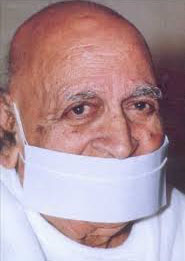The Process of Change
 |
By Acharya Tulsi
Change is the fundamental principle of life. No individual remains the same for long. Nor should he? A child grows into an adolescent, a young man, attains maturity and enters old age. Every individual has to pass through this process of change. That is the inevitable sequence. Change does not relate only to a situation; it can be inner as well as outer: Outwardly, the skin of the body changes; within, all the elements of the body undergo a change. With the chemical changes occurring inside the body, corresponding change occurs in one's character, too. These changes mould an individual's personality.
The individual seeks intellectual development. He wants to develop courtesy in conformity with the age. He is also eager to reform his habits. How to change one's habits has become a great problem. In order to establish harmony between the family and society, it is very necessary to understand and use some psychological techniques of bringing about a change in character; otherwise, so much malice accumulates between the members of the same family that life becomes impossible. Mutual suspicion is created, misunderstandings grow. The non-removal of these factors results in increasing acrimony which gives rise to mental conflicts. To maintain a balanced outlook under these circumstances, it is necessary to change one's habits.
Some people are addicted to being intoxicated. The use of intoxicants strengthens this habit. Once this habit is confirmed, there is excessive use of intoxicating drugs. Too much of a dose and too frequent, makes a man so dependent" on the drug that it is no longer in his power to abandon it". Addiction to intoxicants creates all kinds of problems-physical, mental and financial. The disintegration of the bodily system has a direct influence on the mind. Mental disequilibrium gives rise to strife in the family. Irascibility and excitement increase it. Thus, one problems appears after another. All these problems can be resolved through meditation.
Tension is at the root of some habits. The individual continually afflicted with one problem or the other becomes a victim of tension. In order to mitigate that tension. In order to mitigate that tension; he takes to intoxicating drugs. This affords some superficial relief, but the inner tension becomes more pronounced. That inner turmoil no intoxicants or drugs can remove. Scientific experiments conducted at various places have proved that hypertension which medicines failed to alleviate, was quite resolved through meditation. Our experiences during the shiver-period have also established that the individual undergoes a great change while practicing meditation. Many people given to excessive use of intoxicants, and others suffering from causeless excitability have been found to change greatly after attending a dhyana-shivir.
It is an indisputable fact that the more tense a man is , the more stubborn he becomes. In a state of obstinacy, he cannot realize his error. The psychology of dhyana can create a state of non-insistence. Meditation in itself, is an exercise of humility, of non-prejudice. During meditation the ego dissolves, pertinacity disappears, gentleness grows and pliability develops. The reason is clear the practitioner of meditation makes progress in the direction of direct experiencing of truth. When truth is realized there can be no obstinacy of any kind. Only one who knows truth by hearsay may be importunate but the man who perceives truth directly surrenders himself completely to it and in such a situation there is no room for any kind of obduracy to develop. It does no require any effort to bring about a change in a non-assertive individual; the change there occurs spontaneously. Through meditation the whole structure of tension is shattered. One's vision grows clear. Willfulness ends, and a pliable mind can spontaneously give up any wrong habit.
The doctrine of Non-absolutism, Anekantvad or Syadvad (the Jain doctrine of multisided perception) propounded by Lord Mahavir was the fruit of his meditation. How can a sadhak who does not practice meditation apply, the doctrine of Anekant in his life? Also it is only in moments of dhyana that a non-assertive doctrine like Anekant an manifest itself. Now the question is: how can an individual bewildered by his problems, go into meditation? It does present some difficulty. But no difficulty can survive the clarity of vision and high willpower: When a man is so abundantly clear that he can change every habit through meditation, he becomes determined to practice it. With will-power, a man can mould his mind to proceed in any direction whatsoever.
-----------------------------------------------------
Mail to : Ahimsa Foundation
www.jainsamaj.org
R1991